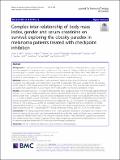| dc.contributor.author | Naik, Girish | |
| dc.contributor.author | Waikar, Sushrut S. | |
| dc.contributor.author | Johnson, Alistair Edward William | |
| dc.contributor.author | Buchbinder, Elizabeth I. | |
| dc.contributor.author | Haq, Rizwan | |
| dc.contributor.author | Hodi, F. Stephen | |
| dc.contributor.author | Schoenfeld, Jonathan D. | |
| dc.contributor.author | Ott, Patrick A. | |
| dc.date.accessioned | 2020-03-25T15:15:13Z | |
| dc.date.available | 2020-03-25T15:15:13Z | |
| dc.date.issued | 2019-03-29 | |
| dc.date.submitted | 2018-09 | |
| dc.identifier.issn | 2051-1426 | |
| dc.identifier.uri | https://hdl.handle.net/1721.1/124317 | |
| dc.description.abstract | A male gender driven obesity paradox (improved survival for overweight/obese patients compared to normal weight) was recently shown in melanoma in the context of checkpoint inhibition (anti-PD-1/anti-CTLA4 monotherapy) in a pooled meta-analysis. We characterized the relationship of Body Mass Index (BMI) with survival and explored gender-based interactions with surrogates of body composition/malnutrition in the context of PD-1 blockade as monotherapy or in combination with ipilimumab in a real-world setting.
Methods
Advanced melanoma patients who received at least one dose of pembrolizumab, nivolumab, or nivolumab plus ipilimumab (combination) from June 2014 to September 2016 were included in this retrospective cohort study (N = 139). Overall Survival (OS) and Progression Free Survival (PFS) were the main outcomes. Analysis was performed using Random Survival Forests (RSF)/ multivariable Cox Proportional-Hazards models.
Results
Overweight/Class-I (25- < 35 kg/m2) obese patients had a significantly lower risk of mortality (adjusted-HR:0.26; 95%CI:0.1–0.71; p-value = 0.008) and progressive disease (adjusted-HR:0.43; 95%CI:0.19–0.95; p-value:0.038) compared to normal-weight (18.5- < 25 kg/m2). Class II/III obesity (compared to normal-weight) had an adjusted HR of 0.42 (95%CI: 0.1–1.77; p-value: 0.238) for OS and 1 (95%CI:0.34–2.94; p-value:0.991) for PFS. Exploration of interactions for OS showed that the association was predominantly driven by males (adjusted-HRmales:0.11; 95%CI:0.03–0.4; adjusted-HRfemales: 0.56; 95%CI:0.16–1.89; p-valueinteraction:0.044); the association was not seen in patients with serum creatinine< 0.9 mg/dL (adjusted-HR:0.43; 95%CI:0.15–1.24; p-valueinteraction:0.020), who were predominantly females. These observations were made in both the anti-PD-1 monotherapy (n = 79) and combination therapy (anti-PD-1/CTLA-4, n = 60) cohorts.
Conclusions
The findings support the existence of an “obesity paradox” restricted to overweight/Class-I obesity in the real-world setting; the association was driven predominantly by males who largely had higher serum creatinine levels, a surrogate for skeletal muscle mass in the setting of metastatic disease. These observations suggest that sarcopenia (low skeletal muscle mass) or direct measures of body mass composition may be more suitable predictors of survival in melanoma patients treated with PD-1 blockade (monotherapy/combination).
Keywords: Anti-PD-1, Melanoma, Body mass index, Creatinine, Obesity paradox | en_US |
| dc.publisher | BioMed Central | en_US |
| dc.relation.isversionof | https://doi.org/10.1186/s40425-019-0512-5 | en_US |
| dc.rights | Creative Commons Attribution 4.0 International license | en_US |
| dc.rights.uri | https://creativecommons.org/licenses/by/4.0/ | en_US |
| dc.source | BioMed Central | en_US |
| dc.title | Complex inter-relationship of body mass index, gender and serum creatinine on survival: exploring the obesity paradox in melanoma patients treated with checkpoint inhibition | en_US |
| dc.type | Article | en_US |
| dc.identifier.citation | Naik, Girish; Waikar, Sushrut S.; Johnson, Alistair E. W. et al. Journal for ImmunoTherapy of Cancer. 2019 Mar 29;7(1):89 © The Author(s). | en_US |
| dc.contributor.department | Massachusetts Institute of Technology. Institute for Medical Engineering & Science | en_US |
| dc.relation.journal | Journal for ImmunoTherapy of Cancer | en_US |
| dc.eprint.version | Final published version | en_US |
| dc.type.uri | http://purl.org/eprint/type/JournalArticle | en_US |
| eprint.status | http://purl.org/eprint/status/PeerReviewed | en_US |
| dc.date.updated | 2019-03-31T03:14:30Z | |
| dc.language.rfc3066 | en | |
| dc.rights.holder | The Author(s). | |
| dspace.orderedauthors | Naik, Girish; Waikar, Sushrut S.; Johnson, Alistair E. W.; Buchbinder, Elizabeth I.; Haq, Rizwan; Hodi, F. Stephen; Schoenfeld, Jonathan D.; Ott, Patrick A. | en_US |
| dspace.date.submission | 2019-04-04T11:41:36Z | |
| mit.journal.volume | 7 | en_US |
| mit.journal.issue | 1 | en_US |
| mit.metadata.status | Complete | |
